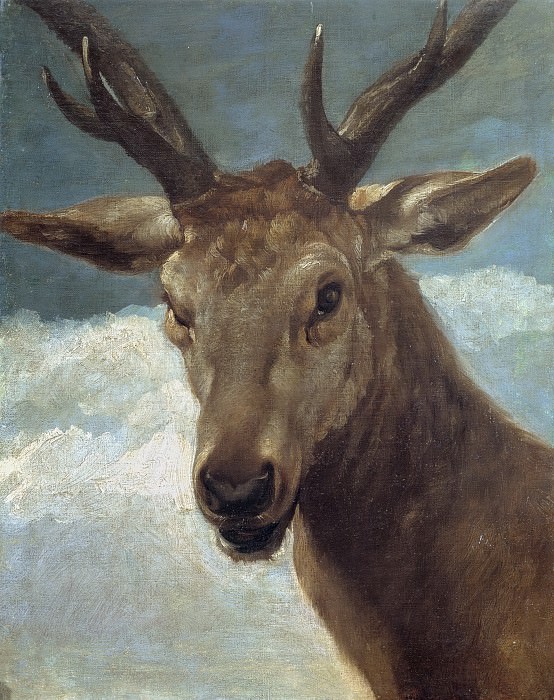Cabeza de venado Diego Rodriguez De Silva y Velazquez (1599-1660)
Diego Rodriguez De Silva y Velazquez – Cabeza de venado
Edit attribution
Image taken from other album: gallerix.org/s/720112932/N/760406390/
Download full size: 2341×2959 px (3,2 Mb)
Painter: Diego Rodriguez De Silva y Velazquez
Location: Prado, Madrid.
The painting was painted in 1634 in oil on canvas. The painting belongs to the Baroque artistic style of the animalistic genre. Diego Velázquez was a 17th-century Spanish painter. He was born into a noble family. Since childhood he showed a great interest in painting, and his father decided to give his son to study with the famous artist of the time Herrera. Becoming an artist for the nobility in those days was not prestigious.
Description of Diego Velázquez’s painting The Head of a Deer
The painting was painted in 1634 in oil on canvas.
The painting belongs to the Baroque artistic style of the animalistic genre.
Diego Velázquez was a 17th-century Spanish painter. He was born into a noble family. Since childhood he showed a great interest in painting, and his father decided to give his son to study with the famous artist of the time Herrera.
Becoming an artist for the nobility in those days was not prestigious. But to learn from a famous Spanish painter Velazquez could not more than a year, as they did not meet in character. Then he began to learn from no less famous Pacheco.
Velázquez already at an early age showed great ability to paint landscapes and portraits. His work became famous at the royal court and he was invited there. There he became a painter at court, his studio was located next to the king’s apartments. In addition to portraits of the royal family, Velázquez painted what he called equestrian and hunting canvases at court. He performs them on the terrace.
In the picture "The head of a deer" actually depicts the head of the wild animal itself. The artist’s paintings were not distinguished by their bright and garish coloring. He often used a black and gray or brown background. But this did not diminish the depth and realism of his paintings. This is proof of the author’s great skill.
The deer is depicted so realistically that it seems to come out of the picture and walk beside it. How skillfully the wool on his forehead is depicted with smooth lines. His paintings are filled with rigor and lightness at the same time. A thin layer of oil shows us the texture of the canvas. The artist was able to skillfully convey light and shadow effects in his works.
His work became a great heritage of Spain and the world. The painter created his canvases without sketches, he could paint any portrait or landscape at once masterfully.
The picture is in storage in the Prado Museum. Spain.
Кому понравилось
Пожалуйста, подождите
На эту операцию может потребоваться несколько секунд.
Информация появится в новом окне,
если открытие новых окон не запрещено в настройках вашего браузера.
You need to login
Для работы с коллекциями – пожалуйста, войдите в аккаунт (open in new window).




















You cannot comment Why?
The subtexts of this painting can be interpreted in various ways. The deer, as a creature of the wild, can symbolize nature, freedom, and untamed beauty. Its direct gaze might suggest a connection between the viewer and the natural world, inviting contemplation on our relationship with animals and the environment. The regal depiction of the deer, with its impressive antlers, could also allude to nobility, power, or even a spiritual presence. Furthermore, the somber and muted background might evoke a sense of melancholy, the fragility of nature, or the passage of time. The painting could be a tribute to the natural world, a commentary on its preservation, or a reflection on the inherent dignity and resilience of wild creatures.